Your first step into the bullet journaling community can be daunting. Plus, most of the inspirational bullet journals online look complicated, and the last thing you want is to spend more time creating the bullet journal than actually using it.
But it doesn’t have to be that complicated. Bullet journaling, after all, is made to be an extremely efficient system. And while there is some prep work you have to do, it’s all smooth sailing once you get your footing. So let’s get straight to it.
What is Bullet Journaling?
The beauty of bullet journaling is that it is completely customizable based on what you want out of it. Devised by Ryder Carroll, the bullet journal is a “mindfulness practice disguised as a productivity system.” More simply, the bullet journal is a system that helps to keep you organized. The quintessential bullet journal is made up of three basic elements, an agenda, a scrapbook, and a diary. The bullet journal can be all of these or a combination of the three based on your needs and interests.
Benefits of the Bullet Journal
Still unsure about starting a bullet journal? That’s okay.
Here are a few benefits the bullet journal has which should get you excited to start on it:
- Managing your anxiety and stress
A bullet journal can be very helpful in helping you manage your mental health. Having a well-organized life will keep your stress levels down, which can do wonders for your mental health. Having a bullet journal can also help you pinpoint what exactly causes you stress and that way you can try to work around it as well.
- Helps you create smarter goals
Smarter goals are achievable goals. Often we can be really ambitious about our goals, and we end up disappointed and unmotivated when we fail to meet them. Having a bullet journal allows you to log your progress for your goals so not only do you stay motivated, but you can also set goals that are reasonable - hence this is one way the bullet journal can help you create smarter goals.

Bullet journals (especially the ones online) can sometimes use a lot of different supplies that you might not necessarily need or know how to use. If you are feeling a little confused, check out our article on Essential Bullet Journal Supplies.
Setting up your Bullet Journal
In theory, the bullet journal is a simple concept, but what usually throws people off is the system and jargon it uses. Terms such as key, signifier, and migration often make the system seem a lot more complicated than it really is. With that, let’s go through some of the terms to make them easier to understand.
Let’s talk about what makes up a bullet journal.
It’s primarily made up of an index and different types of logs, also known as collections. Each log entry you make is a collection. More on that later, first let’s look at the backbone of the bullet journal, the index.
Creating your Index
Your index page is a table of contents that can be found in the first two pages of your bullet journal. You can use your index to keep track of the various sections your bullet journal will have and which pages they will occupy. Of course, this means that you have to buy a journal with numbered pages or number your pages on your own.
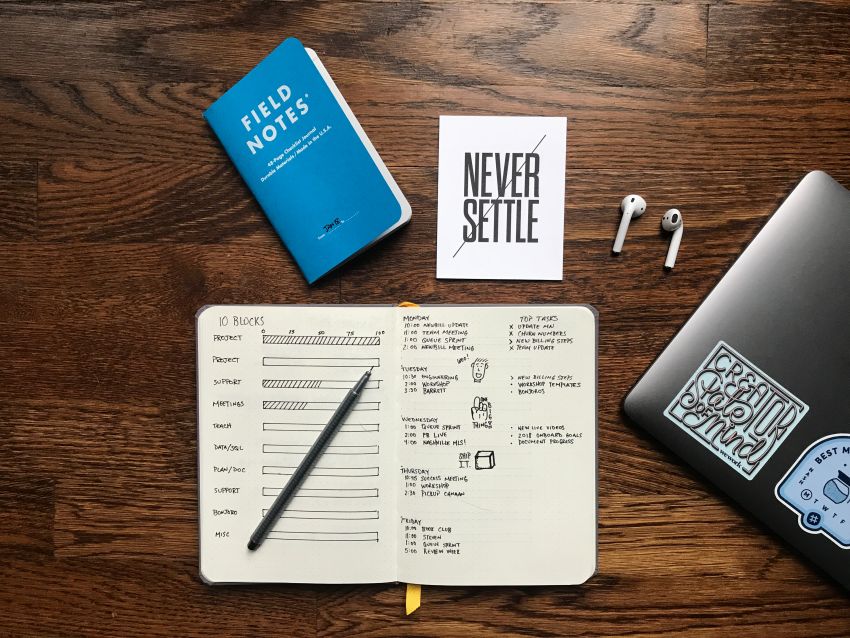
Once you have your numbered pages, you can start carving out the different sections of your bullet journal. Don’t worry about having all your sections together on day 1 - you can always add more later. Remember to leave some space on your index for more sections.
Collections
Collections are the spreads/layouts that you make throughout the journal. Any entry you make into the journal is a type of collection. In general, there are three types of collections, which are:
1) Future logs
Your future log is a spread that shows all the months of the year on a single page. It’s a calendar, an overview of the year ahead. You can use this to highlight birthdays, appointments, any other important date. Head over to our article on bullet journal future log layout ideas and templates for more inspiration.
2) Monthly spreads
Created at the beginning of a month, this spread usually has a monthly calendar with some tracking. Feel free to add some quotes and drawings to really up the aesthetic levels.

3) Weekly spreads
This type of spread usually comes after your monthly spreads. It tracks your weekly activities, and you can go more in-depth by including weekly reflections and notes, whatever you like.
4) Daily spreads
You can go in-depth while writing on your daily spreads. What you choose to track, depends on your creativity and needs, of course. You can track your daily events or even track simple habits such as making sure you drink enough water.
Remember not to limit your creativity as collections don’t just have to be actual lists. They can also be mindmaps, sketches, and doodles. Of course, you can choose what type of collection you wish to see in your bullet journal, so feel free to use only what you need.
Bonus: Trackers!
Trackers are a really fun and creative way to keep track of various habits that you are trying to form or break. You can have water consumption trackers to encourage yourself to drink more water. Or exercise trackers to keep you motivated. You can even have financial trackers to encourage yourself to save more money!
Here is an example of a mood tracker, which some BuJo enthusiasts use to monitor their mental health and productivity:
![]()
The great thing about a tracker is that you can see your efforts and progress in one glance. You can also pinpoint your struggles and take more effective steps to overcome them.
Setting up a Bullet Journal in 3 Steps
Step 1: Choosing your collections
Now that you know what type of collections can be found in a bullet journal go ahead and choose which ones will appear in yours. You can choose not to use certain collections, such as the future log, or create hybrids between two collections.
A great way to choose your collections is to remember that the bullet journal is meant to make planning easier. If your journal is going to be mostly for remembering and planning day to day activities like appointments, your weekly and daily logs are probably going to need more space.
On the other hand, if you have more long term goals, such as saving more money or keeping up with an exercise regime, you can create more “trackers” to log your progress as you go along. You can have as many collections as you like, just make sure you plan for them.
Don’t worry too much about making mistakes here. Like most artistic things, you learn by making mistakes. You will only get better with practice, so use your bullet journal whenever you can.
Step 2: Establish a Key
Usually found on the first page of a bullet journal, think of this as the legend you use to make your journal decipherable. It’s a quick look to see how you classify information. Here is a typical key you can use for your journal:
● Is used for tasks
X Is used for completed tasks
O Is for events
- Is for notes
This is the most basic key out there, and you can easily use it for any type of journal.
Bonus: Migration
If you don’t manage to complete a task, you can choose to “migrate” it to another day or even another month. You can even schedule it for a specific date like this:
> is for migrated tasks
Migrated tasks are often ongoing tasks that you could not complete but are still important enough to be written down for another day.
Eg: Make a card for Mother’s day.
< is for scheduled tasks
As the name suggests, you can schedule tasks that fall on specific dates and times in your bullet journal as well.
Eg: Meet with Jane at 4pm on Wednesday.
Step 3: Make up your own Signifiers
You might be wondering, “why do I need signifiers or symbols in my bullet journal?”
Bullet journals, unlike regular journals, don’t use long sentences to write a point down. In order to make your entries as short and as quick as possible, you need to use rapid logging.
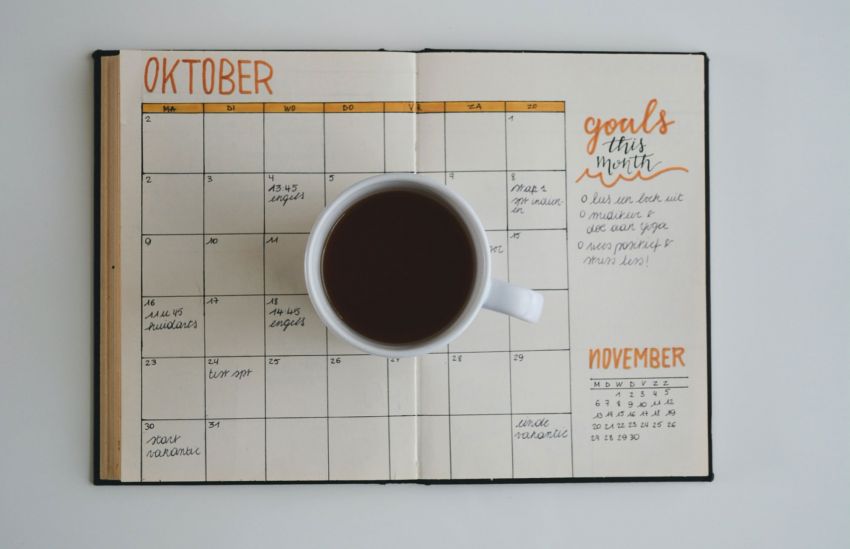
Rapid logging involves using short words, phrases, and symbols to get to the point instead of penning down long entries. So say you need to meet your friend for brunch, instead of writing:
“Meet Beth at the mall for brunch at 12.30 pm.”
You would write something like:
“ O: Brunch with Beth, mall (12.30 pm)”
This is a much more efficient way of writing down your appointments and planning out your day. It also makes it easier to understand how busy your day is going to be at one glance.
You can continue to add on extra indicators, known as signifiers, to help build your index and make your bullet journal more efficient. A great idea is to start out with a pre-determined set and then play around once you get the hang of it.
Some examples of signifiers include:
! for inspiration
Eye for exploring (if you want to look into something more)
$ for the next thing you want to buy
*** For tasks that are priorities
You can customize your signifiers, be as creative as you like! Remember to add your signifiers in your key as well, just in case you forget them.
Some Inspiration for your Bullet Journal
A quick search online shows that bullet journalists can be sorted into two different camps. Minimalist and Maximalist.
Minimalism is when you break down something to its core elements, and in bullet journaling, minimalistic bullet journaling is clutter-free. Many people find it easier to focus on their work when there isn’t a lot of things there.

On the other hand, the maximalist approach happens when you can’t choose an aesthetic. So you take everything. The maximalist approach is playful and really lets you play around and express your personality a lot more.
If you are still not sure which camp you belong in, here are some top bullet journalists for your inspiration!
1. @bulletsandconfetti (56.1k followers)
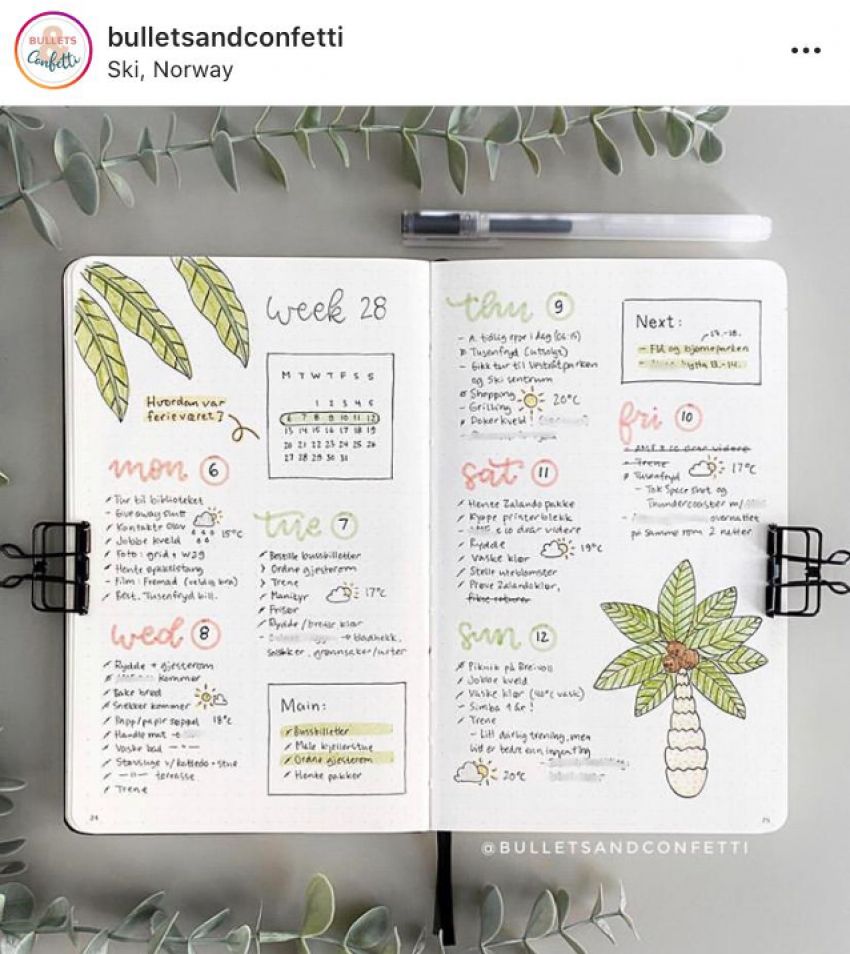
Source: @bulletsandconfetti
The @bulletsandconfetti page is run by a self-proclaimed “semi-minimalist”. The creator features bright colors with cute plants and trees, making up most of the pages. Although the design is mostly simple, it can be a little complicated. Hence semi-minimalist. But the style of the bullet journal is doable!
Here is an example of a minimalist tracker done by the page:
![]()
Source: @bulletsandconfetti
The creator also shows her process in lettering and bullet journaling as she tries out different types of formats and collections. You can definitely use this as a starting point in your bullet journaling.
2. @metro_boulot_bujo (24.8k followers)
This page is a lot more artistic and has bright colors. It also has a lot of ocean/beach themes going for it which makes it very relaxing. Here is an example of a daily spread done by the page:
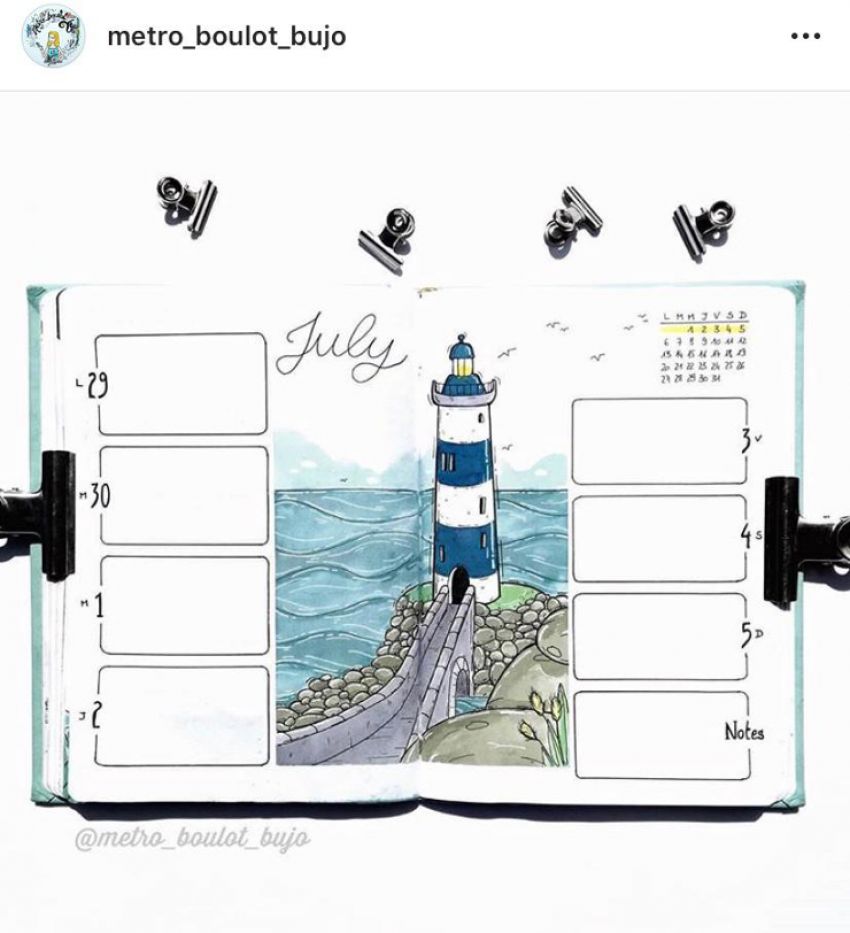
Source: @metro_boulot_bujo
Here is another example of a monthly spread done by the page:
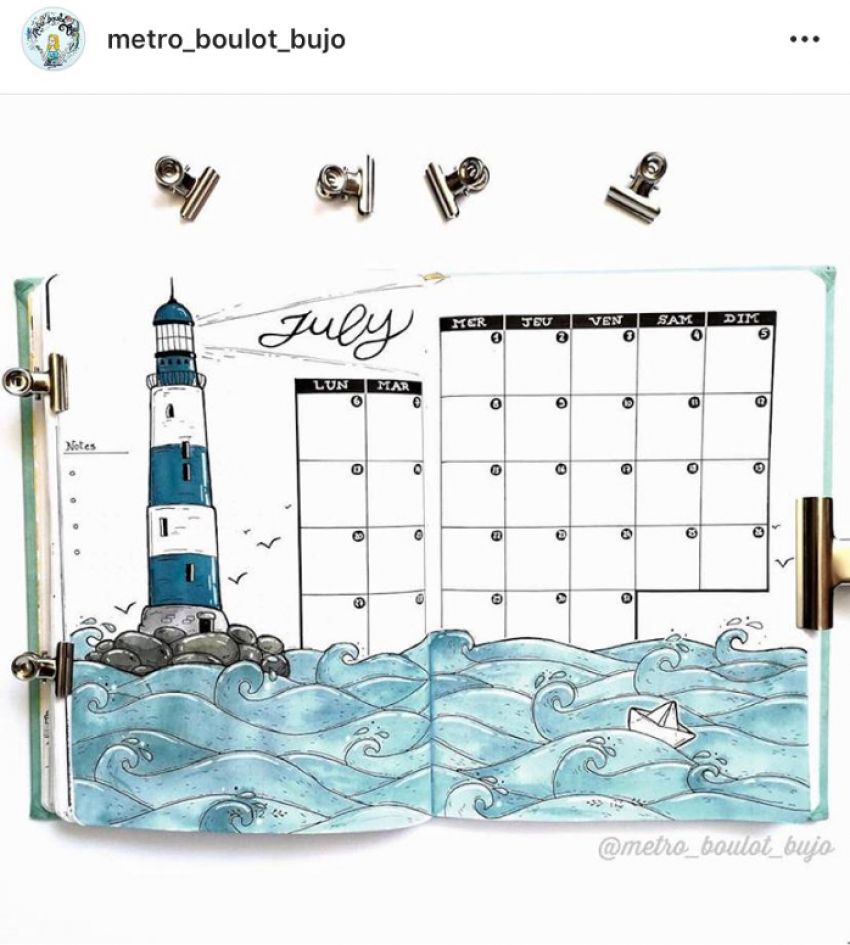
Source: @metro_boulot_bujo
3. @iness_diary (4,022 followers)
We decided to round off the list with a simple bullet journal made by a minimalist. The creator of this journal is an on-the-go business student who has found that bullet journaling has helped her organize her life a lot more.
Here is a weekly and monthly spread by the creator:
Weekly:

Source: @iness_diary
Monthly:
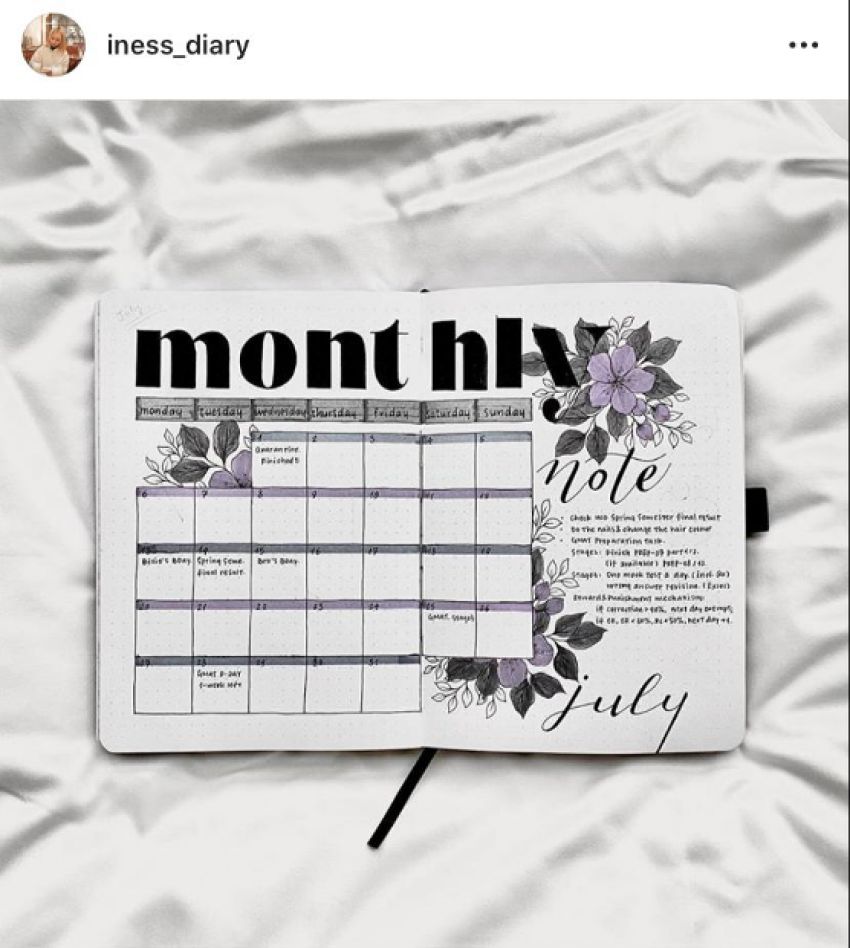
Source: @iness_diary
-----------------------------------
As you begin your first bullet journal, remember to be kind to yourself. The bullet journal, above all, is for your use. So it’s okay if it does not look exceptionally pretty like the ones that you see online or even the ones we have listed above for your inspiration. Have fun and explore the realms of your own creativity to really get the full experience of using this great tool.

















